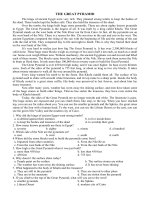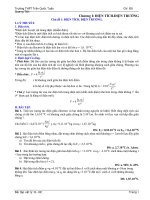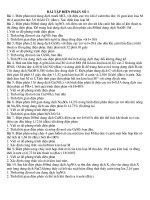Bài tập luyện Reading
Bạn đang xem bản rút gọn của tài liệu. Xem và tải ngay bản đầy đủ của tài liệu tại đây (63.45 KB, 3 trang )
THE GREAT PYRAMID
The kings of ancient Egypt were very rich. They planned strong tombs to keep the bodies of the
dead. These tombs kept the bodies safe. They also held the treasures of the dead.
Over the tombs, the kings built huge stone pyramids. There are about eighty known pyramids in
Egypt. The Great Pyramids is the largest of all. It was built by a king called Khufu. The Great Pyramid
stands on the west bank of the Nile River not far from Cairo. In fact, all the pyramids are on the west
bank of the Nile. There is a reason for this. The sun rises in the east and sets in the west. The ancient
Egyptians compared the rising of the sun with the beginning of life and the setting of the sun with the
end of life. They compared day to life and night to death. This is why they buried their dead on the west
bank of the Nile.
It’s very hard to realize just how big The Great Pyramid is. It has over 2,300,000 blocks of solid
stone. These huge stone blocks weigh an average of two and a half a ton each, as much as a small car.
Some even weigh fifteen tons. Without machinery, the ancient Egyptians cut and moved and lifted each
of these stones. The blocks came from the east bank of the Nile. Slaves took them across the Nile in
boats at flood time. It took more than 100,000 slaves twenty years to build the Great Pyramid.
The Great Pyramid is over 450 feet high today, and it was once higher. Its base covers thirteen
acres. Each of the sides of the pyramid is 755 feet long, or about as long as two city blocks. It takes
about twenty minutes to walk all the way around the pyramid.
Every king wanted his tomb to be the finest. But Khufu outdid them all. The surface of his
pyramid used to shine with smooth white limestone, and its top came to a sharp point. Inside, the body
of Khufu rested in a great stone coffin. His body was preserved to last forever, and about him lay many
treasures.
Now after many years, weather has worn away the shining surface, and men have taken some of
the huge stones to build other things. Thieves has stolen the treasures, they have even stolen the body of
Khufu himself.
Today, the sides of the Great Pyramid are no longer smooth and white. The limestone is gone.
The huge stones are exposed and you can climb them, like step, to the top. When you have reached top,
you can see for miles about you. You can see the smaller pyramids and the Sphinx, the great stone statue
of the lion with a human head. To the west, you can see the Libyan Desert; to the east, you can see the
green Nile Valley and the modern city of Cairo.
1. Why did the kings of ancient Egypt want strong tombs?
a. to defend against their enemies b. to live inside them
c. to keep the bodies and treasures of the dead d. to worship their gods
2. How many known pyramids are there in Egypt?
a. seventy b. eighty c. ninety d. a hundred
3. Which side of the Nile are the pyramids on?
a. east b. west c. south d. north
4.Where did the stone blocks used to build the pyramids come from?
a. Imported from other countries b. From the Nile River
c. From the west bank of the Nile d. From the east bank of the Nile
5. How high is the Great Pyramid when it was just built?
a. more than 450 feet b. less than 450 feet
c. 450 feet d. 755 feet
6. Why doesn’t the surface shine today?
a. People paint on the surface b. The surface stones are stolen
c. The weather has worn away the shining surface d. It has never been shining
7. What happened to the body of Khufu and the treasures?
a. They are still in the pyramid b. They are moved to other place
c. They are in the museums d. They are stolen from the pyramid
8. If you climb to the top of the Great Pyramid, what will you see to the west?
a. smaller pyramids b. the Sphinx
c. Libyan Desert d. modern city of Cairo
THE AKROPOLIS OF ATHENS
The early Greeks used to build parts of their cities on hills. Hills were easy to defend against the
enemy. The Greeks called this kind of hill-city an Akropolis. The name means “high city”. The most
acropolis is in Athens.
If you stand on the Akropolis of Athens, you can see the modern city below you and the blue
Mediterranean not far away. On the Akropolis itself you can see the ruins of some of the most beautiful
buildings in the world.
The Greeks originally build the Akropolis for protection from the enemy. But gradually they
began to use it for religious purposes. On the Akropolis they began to build temples of white marble to
their gods and goddesses. On the temples and in the temples there is some of the finest sculpture and
carving of all time. There were temples on the Akropolis before 500 BC, but many of them were
destroyed in wars with the Persians. Most of the remaining temples were built during the Golden Age of
Athens, about 450 BC. During that time Pericles was the best known ruler of Athens.
The most impressive building on the Akropolis is the Parthenon. The Parthenon is a temple of
white marble. Its beautiful pillars support a heavy marble roof. Inside, there once was a great gold and
ivory statue of the goddess Athena. Athena was the goddess of wisdom. To the Greeks of ancient Athens
wisdom was very important, and they honored it highly. During the Golden Age the ceiling of the
Parthenon was painted red, gold, and blue. The tops of the pillars were painted red, and the building was
decorated with beautiful marble statues of Greek gods and goddesses.
The Parthenon has suffered from war, storms, and the wear of time. The Turks ruled Greece in
the seventeenth century and used the Parthenon to store gunpowder. When the Venetian army attacked
the city of Athens, a shell hit the temple and the powder exploded. This explosion destroyed the center
of the Parthenon and ruined the building. Today most of the marble statues are gone. Many of the marble
pillars lie about on the ground, and the great marble roof has fallen.
The Greek government has rebuilt part of the great temple. At night white and colored lights
shine on the marble ruins, and the words of Pericles come from microphones on the Akropolis.
Sometimes the words are in Greek, and sometimes they are French and English. If you watch the lights
on the marble ruins and listen to the words of Pericles, you can almost believe that you are living in
Athens during the Golden Age.
1. Why did early Greeks build the Akropolis at first?
a. to watch the Mediterranean from there b. to defend against the enemy
c. to use it for religious purposes d. to prevent their city from floods
2. When was the Golden Age of Athens?
a. about 350 BC b. about 400 BC c. about 450 BC d. about 500 BC
3. Who ruled Athens during the Golden Age?
a. Augustus b. Julius Caesar c. Theodosius d. Pericles
4. What was used to build the Parthenon?
a. wood b. limestones c. marble d. concrete
5. Who is the goddess of wisdom in ancient Greek culture?
a. Athena b. Artemis c. Aphrodite d. Hera
6. Many of the temples on the Akropolis were destroyed by whom?
a. the Greeks b. the Persians c. the Turks d. the Venetian
7. What destroyed the center of the Parthenon?
a. a fire b. an earthquake c. a flood d. an explosion
8. What is the Parthenon like today?
a. It is only the ruins of the ancient temple b. It is beautiful like the old days
c. It is newly rebuilt by the government d. It is moved to another place
9. What can you see at night at the Parthenon today?
a. ghosts of the ancient Greeks b. nothing
c. white and colored lights shine on the marble ruins d. Pericles himself
10. What language is the words of Pericles NOT spoken in?
a. Greek b. English c. French d. Spanish
THE GOLDEN GATE BRIDGE
There are many kinds of bridges. A bridge may be a log across a stream or a rope across a river.
But a bridge may also be much more complex. Some bridges are among the most amazing structures in
the world. They’re large enough and strong enough for long trains to cross over. Hundreds of cars can
travel over them at the same time.
Have you ever heard of the Golden Gate Bridge in California? Have you ever seen a picture of
it? Perhaps someone in your family has seen this bridge. It is one of the first sight people see if they are
coming to the west coast of the United States by ship.
Suppose you are sailing into San Francisco. You are near the coast of California. The bridge is
straight ahead of you. At first, it looks like a piece of steel lace across the bay from north to south. Then
your ship sails closer, and the bridge appears larger and larger. At last your ship passes under the bridge.
If you look behind you, you can see this huge structure from the bay. On your right you can see the city
of San Francisco. On your left you can see the cities of Berkeley and Oakland.
The main section of the Golden Gate Bridge is a suspension span. In a suspension bridge the
span does not rest on posts. It hangs from cables. Huge towers support two long steel cables. The cables
are over three feet thick. Smaller cables hang vertically every few feet from the large cables and support
the main span of the bridge.
The suspension span of this bridge is 4,200 feet long between the towers. It is the longest
suspension span in the world. The floor of the bridge is over ninety feet wide, and six lanes of cars –
three in each direction can pass over it at the same time. There are also sidewalks. It is a very long walk
across the bridge, but if you would like to walk, you can watch the ships below. You can see ships from
all over the world sailing into and out of the bay. The bridge is 220 feet above the water, and even the
biggest ships can easily sail under it.
1. How many different kinds of bridges does the passage mention?
a. 2 b. 3 c. 4 d. 5
2. Where is the Golden Gate Bridge?
a. Las Vegas b. Los Angeles
c. New York d. San Francisco
3. Where does the bridge lace across?
a. the San Francisco bay from east to west
b. the San Francisco bay from north to south
c. the San Francisco bay from east to north
d. the San Francisco bay from west to south
4. What kind of bridge is the Golden Gate Bridge?
a. wooden bridge b. beam kind
c. arch kind d. suspension kind
5. How wide is the floor of the bridge?
a. 70 feet b. 80 feet c. 90 feet d. 100 feet
6. How many lanes of cars are there on the bridge?
a. 4 lanes b. 6 lanes c. 8 lanes d. 10 lanes
7. What is used to hang the bridge?
a. cables b. ropes c. wire d. elastic band
8. How far is the bridge above the water?
a. 200 feet b. 220 feet c. 240 feet d. 260 feet
9. What else is there on the bridge floor besides the car lanes?
a. railways b. subways c. highways d. sidewalks
10. How many tower are there to support the bridge?
a. two b. three c. four d. five









